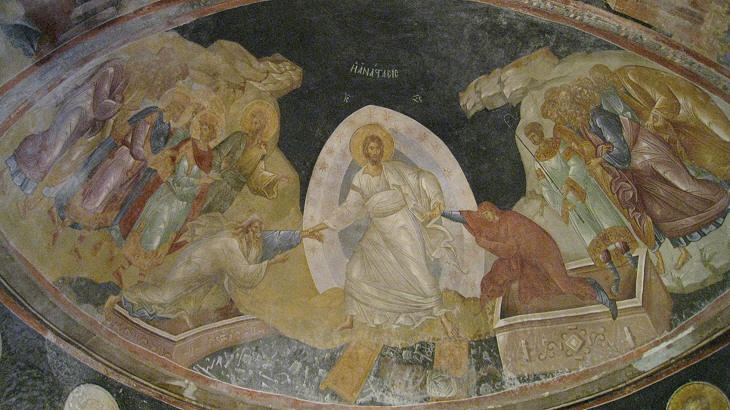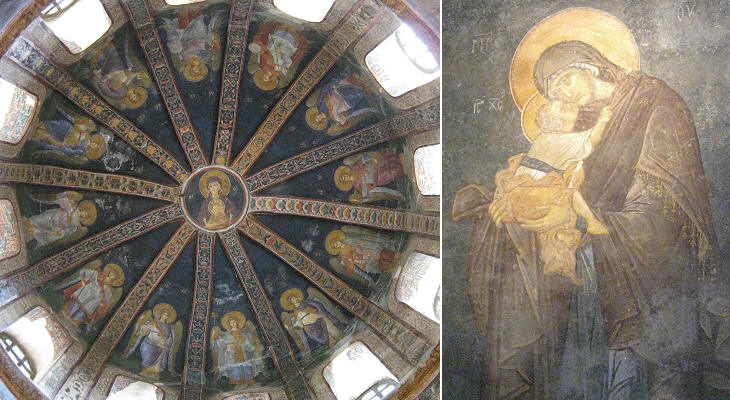  What's New! Detailed Sitemap All images © by Roberto Piperno, owner of the domain. Write to romapip@quipo.it. Text edited by Rosamie Moore. Page revised in August 2015. |
  Byzantine heritage - St. Saviour in Chora Byzantine heritage - St. Saviour in Chora
You may wish to see an introduction to this section first. The church of St. Saviour in Chora was built towards the end of the XIth century, but it was enlarged and embellished with mosaics and frescoes in the early XIVth century. It is the finest monument of Palaeologian Constantinople, the last period of the Byzantine Empire (1261-1453) which was named after the Palaeologos dynasty.
The church was located in an area which was outside the walls built by Emperor Constantine; this explains the reference to Chora (land/fields) in its name. It was included in the walls built by Emperor Theodosius II and it was a very short distance from the late imperial residence of Blachernae.
The iconographic plan of the decoration is very complex: mosaics and frescoes depict scenes which can be grouped into three topics: a) the ancestors of Jesus Christ; b) events of his life; c) events of the Virgin Mary's life. The unusual thing is that scenes belonging to the same theme are not located next to each other, but are distributed in the inner and outer narthexes in an apparently haphazard way. They are accompanied by images of saints, dedicatory panels and deesis, iconic representations of Christ.
It was customary in Byzantine churches to place an image of Christ Pantocrator at the entrance of the main nave. The iconography to be followed was well established; the left hand held a closed book (the Gospel) while the right one was raised in blessing; the view was frontal with the hair centrally parted; the face had a grave expression. The unknown author of the mosaics of St. Saviour followed the tradition and yet the look of Christ is very humane.
Very often scenes depicting events of the life of Jesus or of early saints were set in the historic period they were painted; in these cases Jesus/the Virgin Mary/the saints wore long robes which were thought to be typical of the ancient Roman Empire, while the other characters were portrayed in the costumes of the (then) present time; so the advisors and soldiers surrounding King Herod in the image above give us an idea of the Byzantine court at the time of Emperor Andronicus II (1282-1328).
The mosaics of St. Saviour have been compared with the works by Giotto; perhaps the mosaics by Pietro Cavallini in S. Maria in Trastevere are a more appropriate comparison. Giotto did not use mosaics apart from one for Old St. Peter's, while Cavallini did.
A second deesis is located in the narthex: it is thought to have been inspired by a standing figure of Christ on the Chalke (Brazen) Gate of the (lost) Imperial Palace. It depicted a full length figure of Christ standing on a footstool, with the Virgin at his side in the act of asking for mercy for mankind. Her hands are turned upwards in a very ancient gesture of prayer. This mosaic is thought to belong to the XIIth century (it might have been excessively restored).
The enlargement of the original church as well as the commissioning of most of its decoration was due to Theodore Metochites, an advisor to Emperor Andronicus II. He was portrayed in the act of offering the church to Christ Pantocrator. For the occasion he wore an elaborate costume and a very large and unusual hat, which resembles a turban.
Two small domes were placed at the ends of the narthex; their decoration is very elaborate also in the choice of colours; one dome has bluish tones while in the other red is prevalent. They portray the ancestors of Jesus Christ from Adam to Jacob (left) and the kings of Israel (right); two central medallions complete the decoration.
The Koimesis (falling asleep in death) of the Virgin is first found in Byzantine art in the Xth century. This image soon became a very popular icon. The Virgin was shown lying on a bier, or pallet, for the dead. Christ stood behind her holding up her soul, as if it were a baby, offering it to attendant angels to take to heaven. The apostles stand witness, led by St. Paul at her feet and St. Peter behind her head. It is interesting to compare this panel with that by Cavallini. The walls of the nave are decorated with marble panels made from materials taken from ancient buildings.
Theodore Metochites built a funerary chapel (Parecclesion) on the southern side of St. Saviour. Its decoration is based on frescoes which greatly depart from tradition, probably because the chapel was a less official location than the main church. A large fresco in the apse portrays a dramatic Resurrection; Jesus Christ is surrounded by a mandorla, an almond like shaped aureola: mandorla means almond nut in Italian. This special symbol was used to depict sacred moments such as the Resurrection. This particular iconography is known as the Harrowing of Hell, the gates of which lie beneath the feet of Jesus. The two figures rising up from their graves are Adam and Eve. The subject was a common one, but the fresco technique allowed for much greater movement and more vivid colours than the mosaics did.
A second large and complex fresco depicts the Last Judgement: its design is more traditional. Traditionally in western Europe inscriptions were very rarely used to explain the meaning of a painting, whereas Byzantine mosaics and frescoes often included explanations and quotations. In this painting Jesus says to the condemned souls: Depart from me, ye cursed, into everlasting fire, prepared for the devil and his angels (Matt. 25:41). The large red area is a River of Fire broadening to a lake in which are the damned.
Part of the decoration of the Parecclesion is dedicated to the Mother of God; in particular there is a very nice painting portraying her as Eleousa, the Merciful or more specifically as Glykophilousa, the Sweet Kissing, a sub-type of the Eleousa iconography.
The complex was turned into a mosque by Atik Ali Pacha in the early XVIth century; mosaics and frescoes were covered with plaster and the faces of the angels in capitals and reliefs were erased. The memory of the church's rich iconographic decoration was never lost. In 1948 the mosque was closed and a lengthy restoration brought back to light frescoes and mosaics. In 1958 St. Saviour in Chora became a museum. Introduction to this section Roman Memories Hagia Sophia Hagia Irene and Little Hagia Sophia Roman/Byzantine exhibits at the Archaeological Museum Great Palace Mosaic Museum Byzantine Heritage (before 1204) Byzantine Heritage (between 1204 and 1453) First Ottoman Buildings The Golden Century: I - from Sultan Selim to Sinan's Early Works The Golden Century: II - The Age of Suleyman The Golden Century: III - Suleymaniye Kulliye The Golden Century: IV - Sinan's Last Works The Heirs of Sinan Towards the Tulip Era Baroque Istanbul The End of the Ottoman Empire Topkapi Sarayi Museums near Topkapi Sarayi The Princes' Islands Map of Istanbul Other sections dealing with Constantinople/Istanbul: The Walls of Nova Roma Galata Clickable Map of Turkey showing all the locations covered in this website (opens in another window). |












